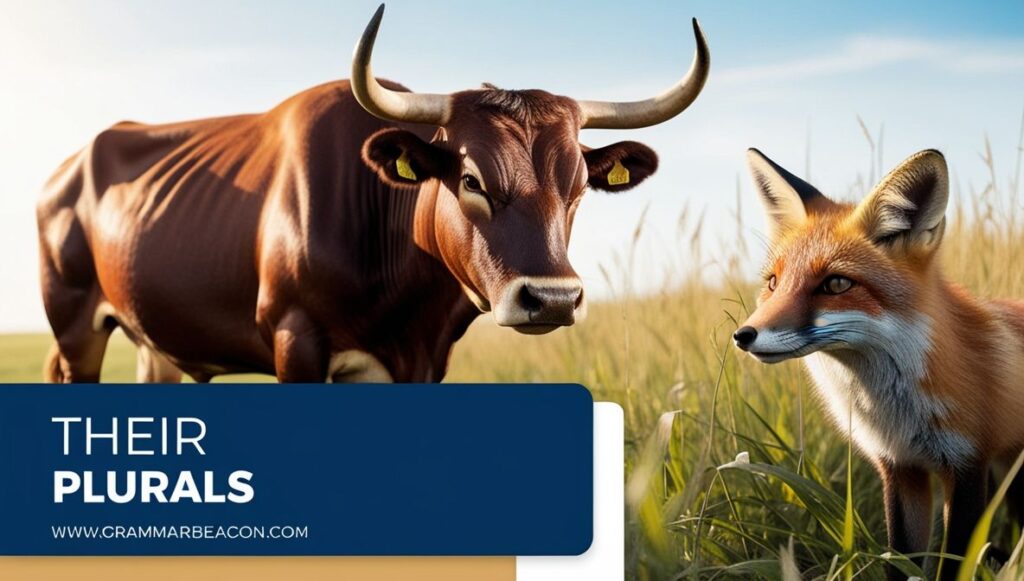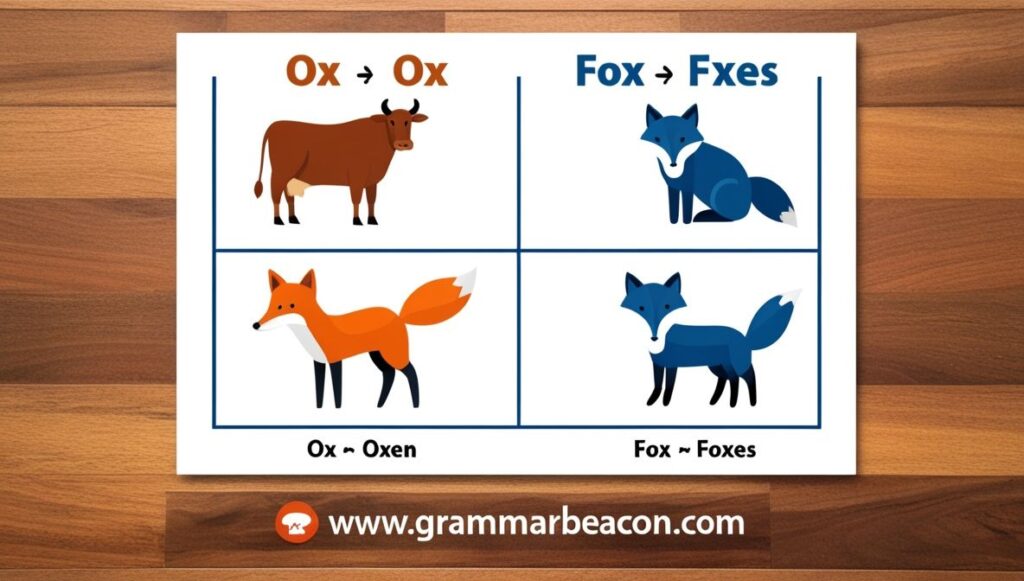The English language is full of surprises. Sometimes, the rules we think we know suddenly change. One great example of this is how we make certain animal names plural. You might ask, “What is the plural of ox?” or “Why don’t we say foxen instead of foxes?” These are common questions, especially for learners trying to understand English grammar rules. In this article, we’ll explore the plural forms in English for the words ox and fox, and why they don’t follow the same pattern.
Many animals, like dogs or cats, become plural by simply adding “s.” But when it comes to an ox and a fox, the rules take different paths. Oxen and foxes may sound alike in some ways, but their origins are rooted in different grammar traditions. The plural of ox is one of the few irregular plural nouns still used today, while foxes fits into the more typical regular plurals category. Let’s dive in and discover why the language works this way and what it says about how pluralization in English has evolved.
Singular Forms: Ox and Fox
In their singular form, both ox and fox are easy to understand. An ox is a strong animal used mostly on farms. It’s a large type of bovine, often trained to pull heavy loads or help plow fields. You’ll still find them in some parts of the U.S., especially in rural or historical areas. People have used oxen for centuries because of their strength and hard work.
On the other hand, a fox is a cunning animal, smaller and wild. It’s known for its reddish fur, clever nature, and quiet movement. Foxes appear in many stories and folktales across cultures. From Fantastic Mr. Fox to Aesop’s Fables, the fox is often shown as smart and sneaky. These animals are also native to much of North America, including parts of the USA.
Though the two animals are very different, they both become plural in English. But the way they do that is where things start to get interesting.
Plural Forms: Oxen and Foxes

In most cases, to make a noun plural, you just add “s” or “es” at the end. That’s the rule for regular plurals in English. You see this with words like cat → cats, box → boxes, and dog → dogs. For fox, this rule applies perfectly. Since the word ends in “x,” we just add “es” and get foxes. It’s simple and follows what we expect when learning about noun forms in English.
But when we try to apply that same logic to ox, things don’t quite work. If you said “oxes”, it would sound wrong. That’s because ox doesn’t follow the usual modern rule. Instead, the correct plural form of ox is oxen, which is part of a small group of Old English plurals that still survive today. Words like children, men, and geese also follow this old pattern. These are known as irregular plural nouns.
This shows a clear difference in pluralization in English. One word adapts to today’s rules, the other holds onto its ancient past. That’s the charm of English it mixes the old with the new.
Oxen:
So why do we say oxen, and not oxes? The answer lies in history. Long ago, during the time of Old English, many plural nouns didn’t end in “s.” Instead, they used special endings like -en. Back then, English had different rules for changing a singular and plural noun. That’s why we say oxen today. It’s not because it makes more sense it’s just what stuck around over hundreds of years.
Here’s an interesting fact: at one point, English used the -en plural for many nouns. Over time, these forms slowly faded. But a few, like oxen and children, managed to survive. These words are examples of historical English word forms, passed down through generations.
We can compare this to the linguistic evolution of plurals in other languages. German, for instance, still uses multiple ways to make plurals, and English once did too. But modern English became more regular and dropped most of these forms, except for a handful like oxen.
Fun Fact: According to historians, “oxen” has been used in English since before the year 900! That’s more than 1,000 years of grammar hanging on.
Foxes:
In contrast, the plural of fox is easy and follows the usual English grammar rules. Because “fox” ends in an “x,” we simply add “es” to make it plural: foxes. That’s the same rule you follow for words like box → boxes or mix → mixes. It’s neat, regular, and makes sense.
This makes the fox vs foxes change easy to remember. And unlike “ox,” “fox” wasn’t around during the time when -en plurals were common. It entered the language later, so it didn’t inherit those old rules. This is why we don’t say foxen, even though it sounds fun. Why foxes not foxen? Because “foxes” follows the rule, and “foxen” was never a part of English usage.
Here’s how the word fits in a sentence:
“The foxes ran across the snowy field.”
This is an example of how plural forms in English work cleanly when the word ends in a consonant like “x.” It’s a perfect sample of a regular plural.
Comparing Plurals:
Let’s compare both words side by side to clearly see the difference in how they change.
| Singular | Plural |
| Ox | Oxen |
| Fox | Foxes |
The contrast is simple but important. While both words are animal names plural form, only fox follows the standard pluralization in English. Ox keeps the irregular plural noun structure from centuries ago. This mix of old and new is a key feature of English, especially when it comes to animals, jobs, or family roles. It shows how language adapts while still keeping some of its past.
If you’re learning English, understanding when to use regular vs irregular plurals is essential. These two animals are perfect examples: one sticks to modern rules (foxes), the other holds onto Old English plurals (oxen).
Why ‘Foxes’ for ‘Fox’ and ‘Oxen’ for ‘Ox’?
This question might seem tricky at first, but it all comes down to historical English word forms and grammar of animal names. We use foxes because it’s a newer word that developed after English had already settled on the regular plural rule. Adding “-es” to words that end in “s,” “x,” “z,” or “ch” is a standard part of how we form plurals today. That’s why we get foxes, buses, and matches.
Oxen vs ox is different because “ox” is one of the oldest words in the language. The -en ending is a leftover from a time when English was still influenced heavily by Old Germanic languages. It’s a linguistic fossil that gives us a peek into how English used to work.
There are a few more examples of this type of irregular plural noun. Here are some:
| Singular | Plural |
| Child | Children |
| Man | Men |
| Goose | Geese |
| Tooth | Teeth |
| Mouse | Mice |
These are part of what makes English language quirks both frustrating and fascinating. You can think of them as the language’s way of showing its long, rich history. And knowing these patterns helps you sound more fluent and natural when speaking or writing.
Conclusion:
To sum it all up, both ox and fox are nouns that describe animals. But when we turn them into plurals, we end up with oxen and foxes. One follows the modern rule (add “es”), the other holds onto an ancient irregular form. These kinds of changes show the deep roots and unpredictable nature of English plurals.
If you’ve ever asked, “How to pluralize ox?” or wondered, “Why oxen not oxes?” — now you know. And if you thought “Why foxes not foxen?” sounded odd, that’s because it never was a word in English. By understanding both the grammar of animal names and the singular and plural differences, you’re one step closer to mastering the English language quirks that give it character.
FAQs
No, “oxes” is not correct. The proper plural of “ox” is “oxen” due to Old English grammar rules.
“Foxen” was never a standard form. “Fox” came later and follows modern plural rules, so we use “foxes.”
Yes, examples include “goose → geese” and “mouse → mice” — all follow old plural patterns.

James Logan is a seasoned blogger and language enthusiast behind Grammar Beacon. With years of experience in grammar and writing, James shares his expertise through insightful and engaging content. His passion for clear communication and linguistic precision shines in every post, making complex grammar concepts accessible and enjoyable for readers. Follow James for expert advice and tips to refine your writing skills.







